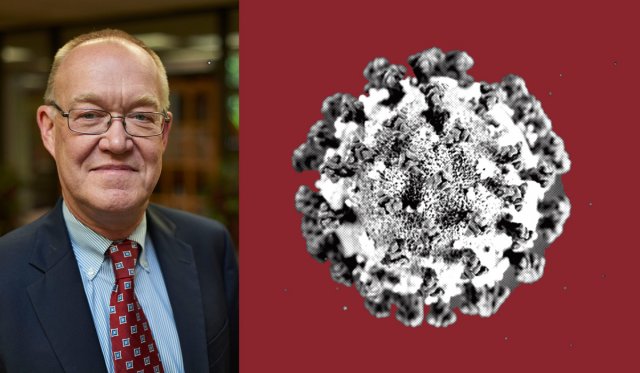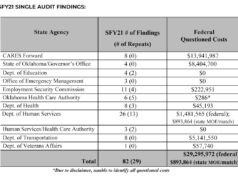
As Oklahomans, Americans and humanity as a whole are learning to practice social distancing to slow the spread of COVID-19, scientists across the globe are trying to develop a vaccine for the novel coronavirus.
In Oklahoma, hopes for a COVID-19 vaccine are no different, and researchers at the University of Oklahoma Health Sciences Center are preparing to start a COVID-19 vaccine project in April.
To explain the science and processes behind such a vaccine’s development, OUHSC Vice President for Research Dr. James Tomasek answered a series of questions over the phone March 23.
It turns out that when it comes to pursuing a COVID-19 vaccine, there is more than one way to skin the proverbial cat.
The following interview has been edited lightly for clarity and to reflect an accurate timeline from the date of its publication.
What is the OU Health Science Center’s intent and role regarding vaccine development efforts?
So Dr. William Hildebrand is a faculty member here at the Health Sciences Center. He is a world leader in looking at when cells get infected with viruses — the peptides they put on their surfaces. These peptides are peptides which the immune system then recognizes to kill the cell that has been infected. So what Dr. Hildebrand is going to be doing — in collaboration with Pure MHC — is he will be identifying the peptides that appear on the surface of infected cells.
Once those peptides have been identified, then Pure MHC will be working to develop a vaccine that would use those peptides to get the immune system essentially ramped up so that if there is COVID-19 infection, the immune system then will be able to respond quickly to that infection.
When does this start, and where will this be taking place?
Dr. Hildebrand is a faculty member at the University of Oklahoma Health Sciences Center, so we will be doing the infection of the cells in our Biosafety Level-3 facility that is located here at the University of Oklahoma Health Sciences Center.
Once he has infected cells and then has isolated the peptides off the surfaces of the cell, then those peptides will go to Pure MHC, which is located here at University Research Park, and they will then identify the specific peptides that are put on the surface. And actually, Pure MHC is a company that was developed from OUHSC technologies that were developed in Dr. Hildebrand’s lab.
And when does this start? Is he over their injecting cells right as we speak? What is the timeline?
We’re getting geared up to do that, so hopefully we will be starting to infect cells within the next two to three weeks. Once he has done that, probably within another month to month and a half, we will have the peptides isolated and will get those to Pure MHC. It will take them several months to get those peptides identified, and then we will work with a company to try to develop the vaccine, which involves, one, generating the vaccine, then doing pre-clinical testing and all of that.
So looking for a true vaccine that would come out of this is a good 12 to 14 months, if everything goes well down the road.
That was my next question. I’ve read that 12 to 18 month is usually the best case scenario. Is this working in conjunction with some of the other efforts? I know you guys didn’t just wake up one day and say, ‘Boy, we should make a vaccine for this,’ and nobody else in the world had thought of that. (…) So how does this all work? Is everybody trying to do this in different laboratories around the country at once or what?
We talk about a vaccine, but there are multiple ways in which to prime the immune system for a virus infection.
You can use live virus, which has been made replication efficient. You can use killed virus. You can use proteins or peptides that are on the virus. You can do like Dr. Hildebrand is doing, in which you isolate the peptides off the surface of the cells when they get infected with virus.
There are 50 different ways that you can try to develop a vaccine for a viral infection. So it’s not like everybody is trying to do the identical thing. Each one is somewhat different and unique, and that’s the beauty with everybody doing this. One, it gives us lots of different opportunities to see what’s going to work, because they’re all a little bit different. And some vaccines work better in certain populations. Others work better in other populations. So having multiple and different types of vaccines is really what we need to tackle a viral infection like COVID-19 virus.
5) Is National Institute of Health money helping funding this? Is OU Medicine funding it as you would typical non-emergent activities? What’s the financial underpinning here?
This is actually being funded through an agreement with Pure MHC and the company. This was the fastest way we could get this up and going, and Pure MHC is interested in supporting this research. So it’s a true public-private agreement to make this happen.
6) Can you talk a little more generally about the COVID-19 virus? What makes it so unusual, and what have you learned about it so far, either in a laboratory standpoint or watching its effects around the globe?
It’s a unique virus that we have not seen previously, which is why our immune systems are not primed to this. So when we get infected, it takes a while for our immune systems to get up to be able to kill cells that have been infected with the virus or to inactivate the virus.
So by the time our immune system gets up and going, the virus has already taken off and is growing and causing problems within the body.
7) Can you speak to folks who might say, ‘Well, this ain’t much different than the flu?’ What warning can you give to people in that regard?
Most of us have seen the flu and have some immune response to the flu, where we may not have the full immune response depending upon the flu strain. We still have some protection against most flu viruses out there. But this is a truly novel virus, so we have essentially no immune protection against this.





















